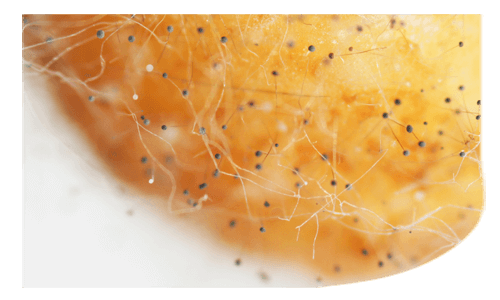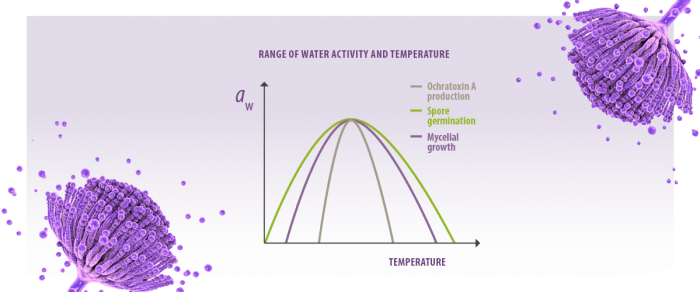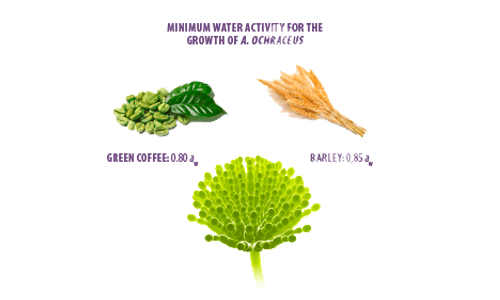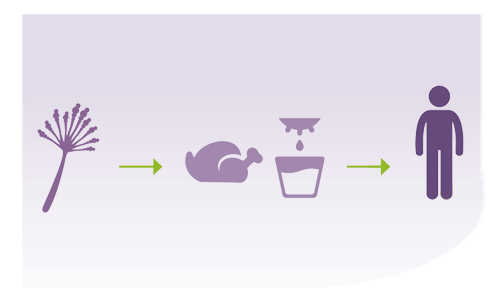
WHAT IS THE FIELD OF STUDY OF YOUR RESEARCH TEAM, AND WHICH ACTIVITIES/ SERVICES DO YOU CARRY OUT?
For more than 40 years, our research team on Applied Mycology has been studying filamentous fungi and their toxic metabolites, using multiple approaches.
During this time, we have carried out many national and international Community-funded projects regarding this subject of study.
Similarly, we have been working closely with the industry, especially in feed and mycotoxin adsorbent production, through joint research agreements. Additionally, we offer an advisory and mycotoxin analysis service via the Scientific and Technical Services (SCT) of the University of Lleida.


REGARDING ANIMAL HEALTH, WHICH FUNGI AND THEIR MYCOTOXINS HAVE YOU FOCUSED ON IN YOUR RESEARCH?
Our extensive experience in this field has allowed us to address, at some point, practically all the genera of mycotoxigenic moulds and mycotoxins that are significant, both for human and animal health.
Thus, we have worked with aflatoxins, ochratoxins, zearalenone, trichothecenes, patulin, and Alternaria toxins.


IN THE LAST 5 YEARS, YOU HAVE PUBLISHED MANY STUDIES ABOUT MYCOTOXINS AND THEIR EFFECTS ON HUMAN AND ANIMAL HEALTH. WHICH ARE THE MOST REMARKABLE OR SURPRISING RESULTS OF YOUR RESEARCH?
 WATER ACTIVITY, TEMPERATURE & MYCOTOXINS
WATER ACTIVITY, TEMPERATURE & MYCOTOXINS
We have determined:
 How water activity (aw) and temperature, among other variables, affect the development and production of mycotoxins in different species of mycotoxigenic moulds.
How water activity (aw) and temperature, among other variables, affect the development and production of mycotoxins in different species of mycotoxigenic moulds. The effects of the interactions between these microorganisms and other competing microorganisms.
The effects of the interactions between these microorganisms and other competing microorganisms.
For example, we have stated that the germination of Aspergillus ochraceus and Penicillium verrucosum spores occurs at a wider range of water activity and temperature than the range that allows for mycelial growth.
Similarly, the range of water activity and temperature in which these moulds produce ochratoxin A is more restrictive than for their growth.

We have also observed differences regarding the minimum level of water activity required for the growth of A. ochraceus, depending on the type of substrate on which the mould grows (for example, 0,80 aw for green coffee and 0,85 aw for barley).

These studies can help the industry to identify critical control points in the production, storage, and distribution of raw materials that are susceptible to colonization by mycotoxigenic moulds.
As a general rule, we have observed that for a certain fungal strain, temperature and water activity are the two factors that strongly influence the contamination of raw materials with mycotoxins, but there are others that play an important role as well:
- ⇰ The substrate on which the moulds grow
- ⇰ The composition of the gas atmosphere that surrounds them
- ⇰ The presence of substances with fungicidal or fungistatic activity
- ⇰ Competition with other microorganisms present in the environment
- ⇰ Irradiation, especially UV light
- ⇰ Fluctuations in ambient temperature
![]() CLIMATE CHANGE & MYCOTOXINS
CLIMATE CHANGE & MYCOTOXINS
Climate change, with its clear influence on ecophysiological factors, such as temperature and humidity, will alter the pattern of distribution of mycotoxins in different types of crops in Europe. This will not only affect how many mycotoxins are produced, but also in which geographic area they are produced, even leading to the substitution of certain toxins with others.
It has been suggested that it’s possible that in Europe aflatoxin B1 may soon become a major food security issue in corn, especially if the temperature increases 2 °C, which is the most probable scenario we should be expecting in the upcoming years.
In this regard, we have been studying the effects that climate change may have on the effectiveness of the fungicides that are currently being used to control mycotoxigenic moulds in crops.
 INDUSTRIAL TREATMENTS & MYCOTOXINS
INDUSTRIAL TREATMENTS & MYCOTOXINS
We have also carried out some interesting studies regarding the effects of different industrial treatments on raw materials contaminated by mycotoxins and how they contribute to the contamination of the final products. We have demonstrated that, in some cases, these treatments can even increase contamination due to the liberation of modified mycotoxins.
Although heat treatments usually have a limited detoxifying effect (due to the thermoresistant nature of these compounds), we have demonstrated that other treatments, such as the fermentation that occurs in baked and pastry goods, increases the number of mycotoxins that end up in these types of products.
This is due to the enzyme-mediated release of the mycotoxins that were bound to the bread dough matrix.
Knowledge of the kinetics of mycotoxin stability during the process of elaboration of food may be a very interesting tool for the food industry as it can be useful in preventing their presence in the final products.
It is important to know the effect that each stage of a certain industrial process has on mycotoxins (increase or reduction of their concentration) when setting the Performance Objectives and the Food Safety Objectives of each process.
 EXPOSURE TO MYCOTOXINS
EXPOSURE TO MYCOTOXINS
Our group has been in charge of a study on the exposure of the population to mycotoxins through ingestion commissioned by the Catalan Food Safety Agency.
From this study, we concluded that the level of ingestion of mycotoxins in the human population in Spain is, in general, low and quite far from the safety levels established by the European Food Safety Authority (EFSA) or the Joint FAO/WHO Expert Committee on Food Additives (JECFA).
- ⇰ However, we also observed that in the case of DON, major consumers of cereal-based food have a higher level of ingestion of this mycotoxin, slightly exceeding the safety level.
- ⇰ In the case of T-2 and HT-2 mycotoxins, the group of young high consumers were shown to be able to exceed the acceptable daily intake.

WHAT ARE THE EFFECTS OF THE CONSUMPTION OF MYCOTOXINS ON THE ANIMAL’S HEALTH?
We should never rule out the occurrence of outbreaks of acute mycotoxicosis that cause the death of a large number of animals in a short space of time due to the ingestion of contaminated feed.
However, the real danger associated with mycotoxins are the effects derived from the chronic and continuous ingestion of small amounts of mycotoxins on the animals’ productivity.
Additionally, mycotoxins severely affect the immune status of the animals, predisposing them to suffer other health problems.

WHY IS IT SO IMPORTANT TO MONITOR THE PRESENCE OF MYCOTOXINS IN RAW MATERIALS USED FOR PREPARATION OF ANIMAL FEED?
The problem with mycotoxins is that, in most cases, their effect is insidious, which means that the farmers can’t fully perceive the damages that the ingestion of mycotoxins have on their animals, both from a health and from a performance point of view.
On the other hand, it is important to stay vigilant regarding the level of contamination of raw materials. Although they usually don’t exceed the maximum permitted or recommended levels of mycotoxins, it is frequent to see multiple contaminations with a combination of mycotoxins that trigger symptoms of mycotoxicosis that are associated with the synergic interactions between different mycotoxins.
We must always keep in mind that mycotoxins entering the food chain via the animal’s feed can end up in the humans when they consume animal-derived food, such as meat, milk or eggs.





 Micotoxicosis prevention
Micotoxicosis prevention